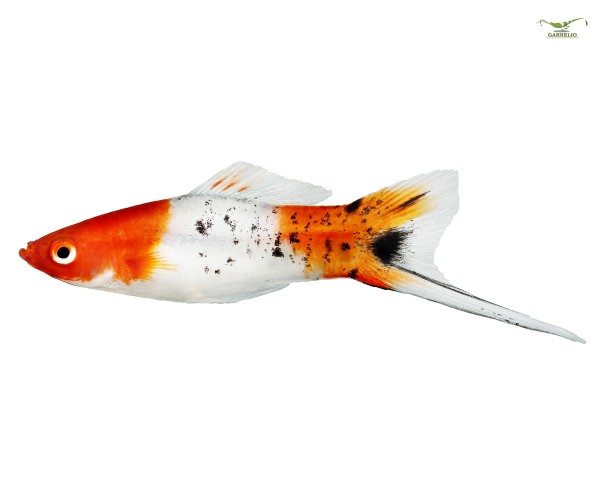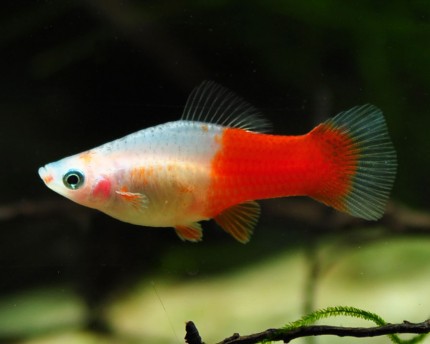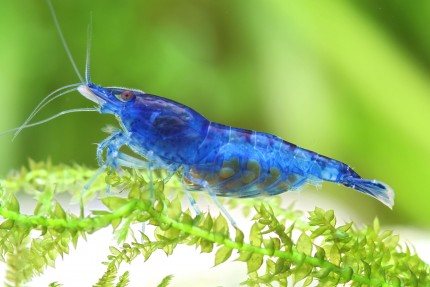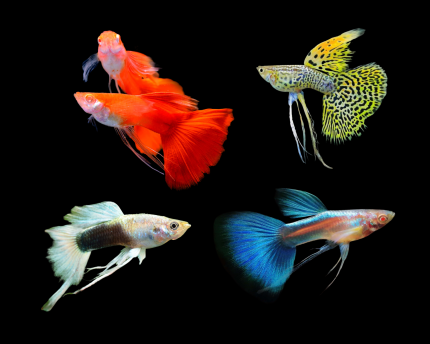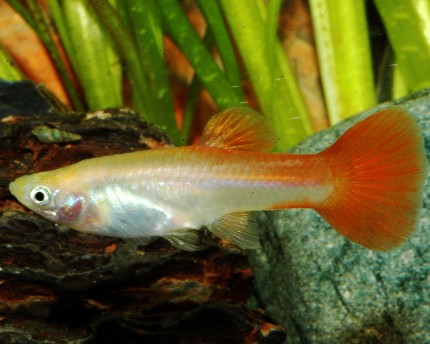incl. VAT plus shipping costs
Currently not available
Delivery only innh. Germany and Austria possible.
Switch to the German store
- Item no: 7743
Fast delivery times
All products are in stock with us!14 years of breeding experience
Let our team of experts advise you!High customer satisfaction
from over 3,000 reviews "| Origin: | South America |
| Aquarium size: | 200 l (approx. 100cm) |
| Final size: | 8-12 cm |
| Difficulty: | 1 - Simple |
| with shrimps?: | with dwarf shrimps, offspring is eaten |
| with dwarf crabs?: | Yes |
| with snails/shells?: | Yes |
| Planting possible?: | Yes |
| Visual effect: | Especially colorful |
| Diet: | omnivorous - omnivorous |
| Fish group: | Tooth carp |
| Water values: | Hard water |
| Pelvic region: | Top |
| Breeding: | simply |
| Temperature: | 18-28 °C |
The red swordtail was bred out of the actually silvery-greenish swordtail from Central America(Xiphophorus helleri). Xiphophorus helleri is closely related to platies, guppies and mollies, like them it belongs to the live-bearing toothcarps. It is so closely related to Platys that fertile hybrids can occur. The red swordtail is conspicuous by its bright orange-red coloration.
The males carry the eponymous sword as a lanceolate extension on the underside of their caudal fin. In the red swordtail, the sword is sometimes adorned with a black stripe. Like the males, the females grow to about 12 inches in size. They are much rounder than the males, lack the sword, and also do not have a gonopodium (the male's elongated sexual appendage on the abdomen).
In its native Central America, the swordtail lives in plant populations on the banks of rivers with rather hard water and a good current. Also in the aquarium the swordtail likes rather hard water with a pH of 7-8.5 and a total hardness of 10 to 30 °dGH and a temperature of 22-28 °C. Since these ornamental fish can become quite large, the aquarium should have from 100 cm edge length. Attention, swordtails jump, so the aquarium should be well covered. These attractive ornamental fish are very grateful for good planting. Please keep swordtails always in a shoal, the fish are not suitable for single keeping. Since the males are quite pushy, there should be enough hiding places like caves and dense plant groups in the aquarium.
Breeding is quite simple: the females of the Red Swordtail give birth to live fry after mating - typical for a live-bearing toothcarp. They develop beforehand in the mother's body in the egg and hatch while still in the belly. Only then are they released. A litter of swordtails is about 20-150 fry strong. The females can store sperm and therefore still release a few litters of fry even after they have separated from the males. The better you plant your aquarium, the more baby swordtails will grow. As a rule, the adult swordtails eat their offspring.
You can socialize swordtails well with the robust Amano shrimp, as well as with dwarf crayfish. Especially with smaller shrimp, make sure that the water conditions are suitable for the chosen species and that you choose shrimp that reproduce well, such as Neocaridina or Sulawesi Inland Shrimp. Larger crayfish can be dangerous to swordtails, as they like to gnaw on the long extended fin in particular.
In nature Xiphophorus helleri is an omnivore. It feeds on both plant and animal food: in addition to worms, small crustaceans, insects and insect larvae, the swordtail eats soft plants as well as algae coverings. Red swordtails in the aquarium are also known as algae eaters. The beautiful red swordtails are considered to be robust and uncomplicated fish. In principle, they take all types of food for omnivorous ornamental fish in the aquarium: flake food or granulated food with plant and animal components are particularly suitable here. In addition, we recommend the administration of frozen food and also live food such as grindal, water fleas, artemia, shiny worms, enchytraea and black, white and red mosquito larvae.
Our feed recommendation NatureHolic Guppyfeed is a fine soft granulate with 0.5 mm grain thickness, which is suitable as a staple food for all aquarium fish and especially for guppies. The soft consistency of the food beads is reminiscent of that of natural insect larvae. It protects the sensitive fish mouth from micro injuries caused by hard or sharp-edged food. In addition to animal food, guppies also need a vegetable component in their diet. As special additives we add garlic extract and the leaf powder of the miracle tree Moringa olifera to NatureHolic Guppyfeed. These herbal additives are attributed positive effects on the immune system and the colorfulness of the colorful fish.
Our plant recommendation: For planting, use NatureHolic InVitros. These are free of snails, planaria and other unwanted co-inhabitants. Also free of algae spores, bacteria and fungi.
Expert Tip: We recommend for fish keeping the NatureHolic 3 Phase Liquid. The care set offers the best all-round protection for your animals. It ensures optimal conditions for successful breeding and keeping.
| Scientific name: | Xiphophorus helleri |
| German Name: | Koi Sanke swordtail |
| Difficulty level: | for beginners |
| Origin/Distribution: | Central America |
| Coloration: | anterior half of body red, posterior dorsum colored red with black markings, middle of body light transparent with black spots. Male with long sword |
| Age expectancy | approx. 3 years |
| Water parameters: | GH 10 to 30, KH 5-20, pH 7 to 8.5, temperature 22 to 28 °C |
| Tank size: | from 80 l |
| Food | Dry food, flake food, GuppyFeed, also needs frozen food or live food, likes soft vegetables or green food |
| Breeding | very easy |
| Behavior | peaceful |
| Group size | Groups of at least 10 animals |
| Further information: | <a href="https://www.garnelio.de/blog/garnelen/welche-fische-vertragen-sich-mit-garnelen="_blank">Which fish get along with shrimp?</a>, <a href="https://www.garnelio.de/blog/aquarianer-tipps/vergesellschaftung-von-fischen-mit-zwergkrebsen" target="_blank">Association of fish and dwarf crayfish</a>, <a href="https://www.garnelio.de/blog/krebse/vergesellschaftung-von-fischen-und-grossen-flusskrebsen" target="_blank">Association of fish and large crayfish</a></td></tr> </tbody></table>
Customer questions and answers Discover now Entdecke die Garnelio Welt! Garnelio gehört zu den größten Onlineshops für wirbellose Aquarientiere weltweit. Last viewed Shopware Agentur six-media.de |

